
From 9 a.m. till 3:30 p.m. last Saturday, I washed knitted wool sweaters plus woven wool skirts, jackets, scarves and slacks. And one wool Army blanket. (Smelled like wet dog, washed it just before lunch when we changed out the water.)
Some of the woolens had been washed previously at the laundromat. I'm always leery of bringing in stray moths when I get woolens from the thrift store so I either store them in the shed or my car's trunk till I can get them washed in hot water and rinsed with a bit of lavender vinegar. And I've learned my lesson about washing thrift store woolens in my front-load washer. It doesn't felt as well, of course, as this old Maytag wringer washer but the main risk is my next several loads of laundry are likely to smell like wet mothballs. So the ones I'd washed late last year at the laundromat were cleared for moths, but hadn't felted as well as I like so they needed a round in the wringer to achieve their fulled potential.
Since my mom's stroke four years ago DH and I've made a monthly commitment to deep-clean her vinyl kitchen and laundry room floors and apply a coat of the shiny "floor finish" she likes. Between moving all the furniture, sweeping with a broom, scrubbing the floor (on hands-and-knees scrubbing, not the long-handled mop kind), waiting for it to dry, then applying the shiny stuff and waiting for it to dry before putting everything back in place, that's easily a two- to three-hour job. This month DH agreed to tackle the floor on his own while I washed woolens with the wringer washer in the shop. He did it because he's a good man but also because he wants a pair of felted mittens to wear, as he said, "the one day every winter when we go out shopping for Christmas." Yes, he had an ulterior motive and it means I have another project added to my list but, hey, I have till December to worry about THAT.
His willingness to help may have been influenced as well by the last trip we made to Activity Day in my car. DH and I were in the front, DS was in the back and the trunk was so full of woolens waiting to be washed that DH had to put his two crates of Squad Leader game pieces and hex maps on the backseat next to DS. When we swung by the farm co-op on the way home to pick up a bag of mineral salt for the sheep and a couple of bags of chicken feed, there wasn't a place to put them except for under the passengers' feet. And since I invariably drive my car, as DH does his truck, that meant he was one of the inconvenienced passengers. So when I arranged the day for cleaning with Mom, I asked to use the wringer washer, too. That's when the Army blanket was added to the queue.
 A few years ago the wringer washer lived in our garage. I used it for much of our regular laundry during the warmer months and whenever I had wools to wash it was right there ready to go. But we have no basement and very little storage space other than the attached garage which also serves as the root cellar in the cooler months. So when our 25-y.o. top-loading washer gave up a few years ago I moved the wringer washer (it was my grandmother's originally) back to my mom's shop and we bought a very efficient front-load washer. (One of these days I hope to have space again for the wringer washer and its tubs.)
A few years ago the wringer washer lived in our garage. I used it for much of our regular laundry during the warmer months and whenever I had wools to wash it was right there ready to go. But we have no basement and very little storage space other than the attached garage which also serves as the root cellar in the cooler months. So when our 25-y.o. top-loading washer gave up a few years ago I moved the wringer washer (it was my grandmother's originally) back to my mom's shop and we bought a very efficient front-load washer. (One of these days I hope to have space again for the wringer washer and its tubs.)Mom's shop only has cold running water these days so DH carried hot water over from her house in 5-gallon buckets. It took two trips or about 3-1/2 buckets to fill the wash tub. Meanwhile, I filled the rinse tubs with cold water. I added two tablespoons of Orvus Paste in the wash tub and 1/4 cup lavender vinegar in each rinse tub. I don't use regular laundry detergent because I avoid washing wool with the so-called brigheners or bleaches that are often added to detergents. Orvus Paste is what I use for washing fleeces and it works just as well on the finished goods.

Once we had the tubs filled, I added the first load of sweaters and commenced to washing. So sweaters in wash tub, wait 15 minutes. Run the wash load through wringer and into first rinse tub. Put next load of sweaters in to wash. Use stick (wonder what happened to the long-handled wooden spoon we used for this purpose when I was a kid?) to poke clothes below level of water and just all around play with the laundry. You know, same way you do with an outdoor fire...
 Then after about 10 minutes, start the batch in the rinse tub through the wringer again. This time they go into the second, or last, rinse tub. Then move back to the washer and wring those clothes, which have been washing for just about 15 minutes, into the first rinse tub. Third load goes in the washer and the countdown starts again.
Then after about 10 minutes, start the batch in the rinse tub through the wringer again. This time they go into the second, or last, rinse tub. Then move back to the washer and wring those clothes, which have been washing for just about 15 minutes, into the first rinse tub. Third load goes in the washer and the countdown starts again. This time there's even less waiting as I factor in how long it will take to run both rinse tubs-worth of clothes through the wringer and still get back to the load in the washer at the right time. It's not a problem if I run the wash longer than 15 minutes, but I've found that's a pretty optimum time for felting most wools and I want to do this as efficiently and quickly as possible without unnecessary delays.
This time there's even less waiting as I factor in how long it will take to run both rinse tubs-worth of clothes through the wringer and still get back to the load in the washer at the right time. It's not a problem if I run the wash longer than 15 minutes, but I've found that's a pretty optimum time for felting most wools and I want to do this as efficiently and quickly as possible without unnecessary delays. In between washing, poking the rinsing (can't forget that important step!) and wringing, I sort the items by color. It's not perfect but I like to start out with the natural or lighter colors first and move through to the reds and then blacks at the last. Many red wools bleed dye so I aim to do them just before the darkest items or before we plan to change out the cooling wash water for hot. And in between washes I top up the washer with hot water from a fresh bucket DH brought over mid-way through the morning. It's surprising to me but the washer does a good job of holding the water's heat, especially when I remember to keep the lid closed except when necessary to pull out/put in clothes.
In between washing, poking the rinsing (can't forget that important step!) and wringing, I sort the items by color. It's not perfect but I like to start out with the natural or lighter colors first and move through to the reds and then blacks at the last. Many red wools bleed dye so I aim to do them just before the darkest items or before we plan to change out the cooling wash water for hot. And in between washes I top up the washer with hot water from a fresh bucket DH brought over mid-way through the morning. It's surprising to me but the washer does a good job of holding the water's heat, especially when I remember to keep the lid closed except when necessary to pull out/put in clothes.
At lunchtime, DH drained the washer and I did the same with the rinse tubs. The tubs are made with a fixture on the bottom where a hose can be attached but we just used the buckets and emptied them outside around flowers or shrubs. It's been so dry here this winter they can use all they can get.
Mom often fixes Saturday lunch for a friend who helps her with landscaping and house maintenance so she increased her covers to include us as well. (The menu was country-style steak, mashed potatoes, green beans, sauerkraut, fried apples, cornbread and chocolate cake -- well worth stopping work for!) After lunch, DS helped his grandmother clean up, DH carried fresh hot water for the washer and I refilled the rinse tubs. I was ready to get the job finished. And DH still had to clean the floors -- he didn't want to interrupt lunch preparations in the morning but once the dishwasher was running he got to work, too.

Final count was 69 sweaters, 2 scarves, 10 jackets, 9 skirts and 2 pairs of pants. And can't forget the one Army blanket. So it wasn't QUITE 99 sweaters but 93 woolen items is close enough for me.
*DH has this habit of ad-libbing lyrics and he couldn't keep it to himself while we were unloading baskets and bags of sweaters for washing. And you know how it is when you get a song stuck in your head. Especially a silly one.




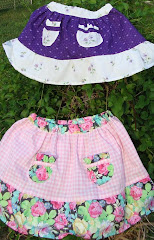









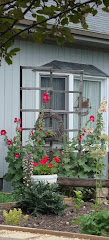

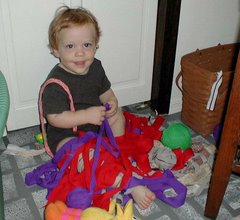
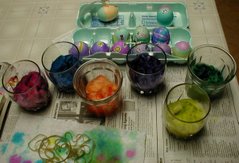
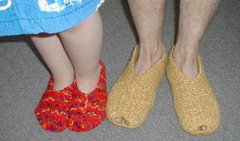
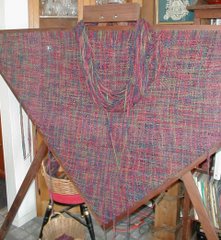
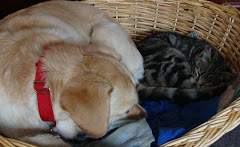

9 comments:
clothes can wrap around the wringer and be torn?
That could happen but it's not very likely if I'm careful to stand to the side of the wringer as I start the fabric through on one side while, with the other hand, reach for the piece as it comes out on the other side. I find clothing items with thin straps or attached belts are the worst for that but I can circumvent the problem by feeding a larger section of the clothing through first and letting the straps or belt follow.
I think the worst problem with using a wringer is when an article of clothing has large buttons or buckles attached to it. If I don't fold the piece carefully to sort of "hide" or protect the button in the folds as I feed it into the wringer, there's a strong risk that I'll flatten or break buttons in the process.
Back in 1976-78 we lived in an old farmhouse outside of Fort Dodge, Iowa and My dad bought me a wringer washer that I put in the basement and would take the laundry out the old cellar door to the clothesline. I loved that machine. But when we moved to St Louis we did not have room in the U-Haul truck and I had to leave it in the house. I had also canned about 100 jars of veggies from our garden that year and there was no room in the truck for them either. That was the best garden we have had in\the last 38 years. I hope this year is good. We really have to amend the soil. But, I was wondering what is Orvus? I have never heard of it before.
Thanks!
P.S.
Do you look for sweaters that are 100% wool? Or do you find that certain fiber combinations felt just as well? And may I ask, how long did it take you to gather 93 sweaters?
Hey, Jenn, nice to hear from you!
I hated when I had to move the wringer back out to mom's but I wasn't using it year-round and, without a basement, space is at a premium here. When I get the garage sorted out (mainly add shelves to the walls and refinish a hoosier cabinet setting out there waiting to move to the kitchen where it belongs) I plan to move the washer back here. (I think I'd cry if I had to leave it behind in a move.)
Orvus Paste is a ph-neutral detergent/shampoo marketed for horses. It's often recommended by textile conservators because it's so gentle and yet effective. I buy it by the gallon at the local farm co-op and use it to wash sheep fleeces and any other protein fibers I'm working with. (And sometimes Holly-dog!) I think nowadays Proctor & Gamble sells it in smaller sizes at quilt shops, too.
I try for 100% wool sweaters and woven fabrics but if it's a color or pattern I really like, I'll go up to 20% of another fiber. Sometimes those won't felt as well as the 100% wool but if I'm paying 50¢ to $1 per piece, I'm willing to take a chance. And I avoid any items labeled machine washable as that means they're made from superwash wool (treated to avoid felting).
It took me almost 6 months to gather that many sweaters. :D But if I hit a couple more "50¢ each" sales at the thrift store I bet I could gather that many in less time!
Hi,
My nephew found your site and thought I would be interested. I have a blog - sharpshooter77 Homefront Cooking and also a personal blog. I don't blog that often but I also grow organic garden with lots of help from my nephew. I freeze or can a lot of our foods and try to cook healthy. I was very interested in the wringer washer. Something I might like to try and also quilting. Read several of your blogs. Sounds like you have and interesting and wonderful life.
Thanks for the note, Sharpshooter77. The wringer is a favorite of mine -- so useful and the rhythm of using it is very relaxing even tho there's work involved. ;)
This may be a dumb question but what do you do with all that wool?
I have a craft called Penny Rugs. Its a table rug made of felted wool (which I do). I cut pictures out of 100% wool and blanket stitch them on a large piece of wool. Kind of like a picture. I back the wool with cotton fabric.
examples of this craft are on etsy.com.
I love all these blogs. We are not ready for homesteading but getting close and educated. Thanks
Not a dumb question at all, Glenda. I've never made a penny rug but I have one an aunt made years ago -- it's on my list to try. ;)
I cut the felted sweaters up and use them like I would regular fabric, sewing things like purses and bags, pincushions, mittens, slippers, pillows, dog coats, trivets and hot pads. I've recovered a couple of footstools and made pads for chairs with thick felted wool, too.
That stuff wears like iron and can be needle-felted, too. Makes for great combination when decorating for style while keeping day-in and day-out use in mind, too.
The woolen suiting fabric I mainly use for rug hooking/braiding and as regular fabric. Flannel-backed afghans or blankets pieced like quilts are a favorite use.
Having a big selection of colors and thicknesses to choose from makes designing my projects easier and more fun.
Start small on the homesteading ideas and just adapt for where you're at. Lots of self-sufficiency ideas just require a willingness to work rather than a particular setting.
Post a Comment